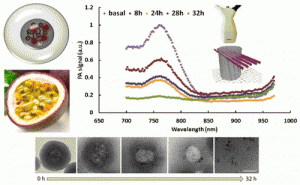Photoacoustic imaging (PAI) is a promising noninvasive technique for molecular and cellular characterization of cancer. Cancer detection by PAI is an area of active research, and the recent advent of contrast agents based on near-infrared (NIR)-absorbing dyes or organic/inorganic nanoparticles tremendously improved the specificity and the signal contrast. In the paper published on The Journal of Physical Chemistry C by Domenico Cassano and Valerio Voliani from NEST (in collaboration with a grop from Institute of Clinical Physiology, National Research Council and Fondazione CNR/Regione Toscana G. Monasterio in Pisa), the photoacoustic (PA) signal enhancement produced by biodegradable passion fruit-like nanoarchitectures in phantoms and ex vivo is reported. By this approach, the synergistic interaction between commercial NIR-fluorophores and ultrasmall metal nanoparticles is exploited to produce a PA signal enhancement in the biological window. Moreover, the degradation of the nanoarchitectures is investigated in physiological environment as reference matrix.
More details can be found HERE

